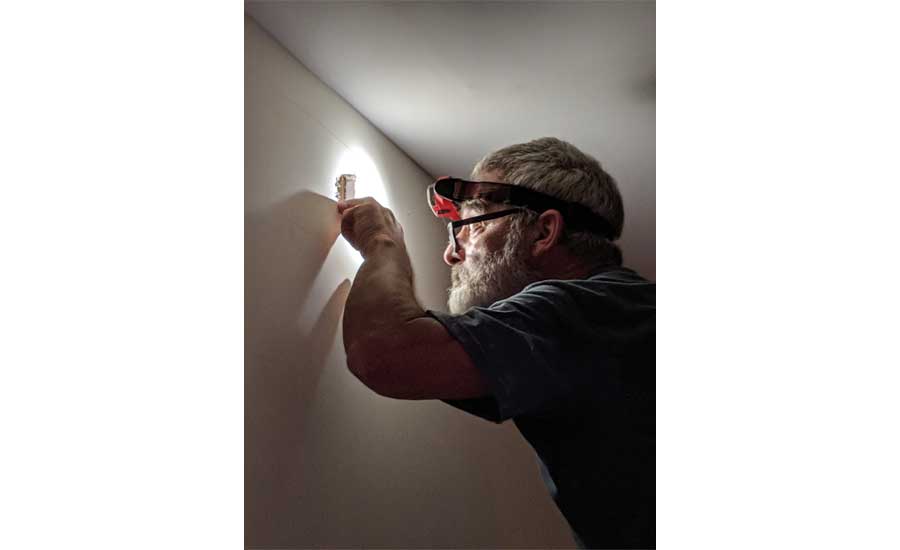YouTube Gives Rise to New DIY Crowd, Marketing Opportunities
Contractors discuss how to handle DIY situations, using YouTube to their benefit

DIY ISSUES: YouTube only covers the actual process of completing a task; it doesn’t give the whole story, and this is where problems can arise, even if the homeowner performs the task correctly.
With more than 2 billion users watching an average of 1 billion hours of video daily, YouTube usage accounts for almost a third of the internet. On mobile devices alone, the company reports that it reaches more people in the U.S. audience than any TV network. What began as a platform to communicate about personal happenings has become an open forum of videos, spanning diverse topics that are giving rise to an advanced do-it-yourself (DIY) crowd. From car repairs to ductwork replacement, trade professionals are faced with the consequences of YouTube learners.
Despite these challenges, some contractors have found that YouTube for the HVAC industry has a beneficial side as well.
"We're in a skilled trade in HVAC, and with the way the industry keeps changing and the trends with new equipment, sometimes Google and YouTube are the best ways for us to get information quickest,” said Pete Huey, general warranty service manager at Chas Roberts, Phoenix, Arizona. “YouTube can be invaluable for troubleshooting and finding resources.”
That being said, Huey doesn’t rubberstamp the content found on YouTube. Instead, as a professional HVAC technician, he takes a “trust but verify” approach.

CUSTOMERS ARE WATCHING: YouTube usage accounts for almost a third of the internet. On mobile devices alone, the company reports that it reaches more people in the U.S. audience than any TV network.
"One thing I tell everyone I train is that everything we do in this trade can kill you if you're not careful, and it will hurt the whole time you're dying,” he said. “With my technicians I always tell them to verify everything on YouTube. If you see one video on a topic, check it out. If you can't find another source that says something very similar, it's probably not the right thing. Anything that we do in our trade should be readily available to be verified. If you can't verify it, don't go with it.”
Chas Roberts not only uses YouTube videos for internal education but also creates educational YouTube videos for its customers. These five-minute videos, posted once every two weeks, address common issues that affect homeowners. Some examples include thermostat programming, good set points to maintain comfort in the home, and humidity issues. The company does not include detailed technical information but instead provides a more instructional piece on how a system works and what customers should expect it to do.
New DIY Crowd
Part of the growing DIY crowd was created by accident. YouTube is the second-largest search engine on the planet, second only to Google, which owns YouTube. Curious customers trying to understand what HVAC contractors have told them will often end up on Google — which, in turn, displays YouTube videos near the top of the search results.
“People are just a lot more inquisitive these days than they used to be because the knowledge is at their fingertips,” said Chris Crawford, owner of Spring Branch A/C, Houston, Texas. “If you say something to a customer like, ‘You should probably replace your thermostat,’ even the least mechanical homeowner, who has never even thought of replacing a thermostat themselves, could end up on YouTube watching a how-to video.”
It is this chain of events that has created a new group of DIYers — and has also introduced skepticism into the prices being charged for the effort being exerted. When customers see how allegedly simple a repair can be, and then look up much the parts cost online, many of them start asking contractors to justify why the contractor is charging what they feel is so much money.

SYSTEM FAILURES: Some DIY repairs are simple but when customers begin to change ductwork then they risk unbalancing the entire system and premature failure.
"We've run into instances with do-it-yourself homeowners who are trying to make repairs on things that really need to have a skilled laborer,” said Huey. "There's a reason why there's a label on the machine that reads, ‘This should be serviced by a skilled professional.’"
He then gave an example of a homeowner who almost electrocuted herself approximately six months ago because she was trying to change her own capacitor. She didn't realize she should turn the power off before starting the project and almost blew her finger off.
Her response? "Well, I saw it on YouTube."
“If there was one thing we could get across to people who don't work in the skilled trades profession, is that Google and YouTube are great resources, but they're not the experts,” said Huey. “There's a reason why air conditioning technicians go to school to learn what we know how to do. The technician had to go to school and learn this information. He had to pay all that money in advance to fix a customer's house. They are paying for that.”
He furthered explained that when customers are paying for a paid service call, they aren’t paying just for the time and parts to do the job. They are paying for the level of intelligence and skill of the technician to get the job done.
"We get the occasional ‘Why are you charging me so much for a capacitor when I saw on YouTube that it doesn't take but a minute?’” said Martin Hoover, president of Empire Heating and Air Conditioning in Decatur, Georgia. “We have responses for these types of questions ready, such as ‘We check the system after and guarantee the work.’ We have a list of reasons to back up why we charge what we do."
Hoover said that YouTube only covers the actual process of completing a task; it doesn’t give the whole story, and this is where problems can arise, even if the homeowner performs the task correctly.
"You can look on YouTube about how to install your new capacitor, but it doesn't tell you how to test the system to make sure the capacitor was the only problem or that the rest of the system is working correctly,” he said. “If you can't do the whole job, then you should have a professional do it. They will completely test the system, not just accomplish the one repair."
With run capacitors, there is usually a reason that the part failed, and replacing it will only address the symptom. A dirty air coil that is restricting airflow or the condenser fan motor over-amping could be the actual problem, and when they aren’t fixed, that homeowner will be replacing run capacitors all the time.
"I think that using YouTube for infomercials is a good idea,” said Hoover. “It is good to show people the things you do and how you do it. It's like with coil cleaning, for example. People think you just take a hose and get to it. Well, there's a lot more to it than that. Showing and educating the customer of the actual labor you’re doing is a good thing."
Cost Effective Marketing
In addition to educating its customers, Empire Heating and Air Conditioning is also using YouTube to market the company and its services. The videos they create are primarily sales and promotional. The company is also spending part of its marketing budget on YouTube advertisements.
“This is a very small investment for a lot of reach,” said Hoover. “We are seeing some good results from our efforts with this platform so far.”
Crawford has previously invested the money for TV commercials and agrees that YouTube is beneficial to contractors for the notoriety achieved with the lower buy-in rate.
“The number of dollars that you have to drop to advertise on television and radio and all of what used to be the normal places to go advertise can be ridiculous,” he said. “You can advertise on YouTube, push your name out there for 100 bucks or less, and still get your name out there.”
Compelling videos can be the key to making YouTube work for a company, but just about any video should help with branding and advertising. Crawford thinks that helpful videos are what will eventually bring the DIY crowd to the contractor.
“There's only so much that a DIY person can do, and the typical DIY guy doesn't have a recovery machine or a welding rig, or a $1,000 in equipment to be able to go do a job one time at their house,” he said. “We're not threatened by that. The stuff that a DIY guy is going to do is not going to cost us very much; that's why we actually promote it, so that people can look at it and see it and maybe not screw it up. Then when something big happens, they'll say, ‘Crap, that's out of my range — let me call up Spring Branch and see what they can do.’”
DIY Danger Warning
Joseph Kokinda, president and CEO of Professional HVAC/R Services Inc.™ in Avon Lake, Ohio, is concerned about the danger of incomplete or disinformation on YouTube. Here, he explains his own experience with a potentially deadly gas line tubing that is marketed to DIYers and promoted in hundreds of DIY YouTube videos regarding this pipe.
Corrugated stainless steel tubing (CSST) pipe — usually yellow in color — is sold at Home Depot and many other locations for the enterprising DIYer to tap into an existing black iron gas supply at their homes to add a grille, hot water tank, stove, or any other appliance. The YouTube videos are out there.
The stores sell to anyone; however, the Code requires a notice to any purchaser to actually fill out a disclaimer, located at the service counter where returns are located, that absolves the vendor from liability relative to improperly installing this piping system.
The problem is that the grounding of any of these systems is a very important safety issue that sadly is not followed. The advent of perforated tubing happens, and is documented by the National Fire Protection Association (NFPA) and many news pieces all over the country, where a house blows up after this piping fails due to ground strikes of lightning, sometimes 10 miles away from the location.
Gas leaks into the area, sometimes an attic, and when a spark ignitor or open pilot flame happens, the result is catastrophic.
If you research this on Google, you can see why the grounding of this piping system is important to the end user. At commercial supply houses, it will not be sold to any contractor without verification that the technician who is purchasing this material has been trained and is knowledgeable in the proper installation metrics. Home Depot and others will sell to anyone. For this reason, we do not use this system at Professional HVAC/R Services Inc.™ for any heating or natural gas applications. As a matter of fact, when we purchased one of our buildings years ago, we found that this CSST pipe was used improperly by the previous owner — a DIY expert — and was not grounded.
We pulled it out. The grounding process must be a heavy gauge wire and pulled to a real ground rod outside the abode or building. This process is not followed; instead, a metal piece or the black iron pipe is thought to be effective as a shortcut.
Source: Joseph Kokinda, president and CEO of Professional HVAC/R Services Inc.™ in Avon Lake, Ohio.









